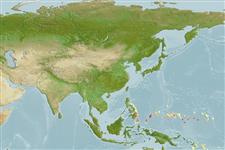Klassifizierung / Names
Namen | Synonyme | Catalog of Fishes(Gattung, Arten) | ITIS | CoL | WoRMS | Cloffa
>
Gobiiformes (Gobies) >
Gobiidae (Gobies) > Gobiinae
Etymology: dabra: Named for David Winterbottom and Bradley Hubley, an arbitrary combination of letters, 'dabra'.
Eponymy: This is an arbitrary combination of letters combining the first few letters of the given names of Winterbottom’s son, David, and of Bradley Hubley who is entomology collection manger in the Department of Natural History at the Royal Ontario Museum. [...] (Ref. 128868), visit book page.
More on author: Winterbottom.
Environment: milieu / climate zone / Tiefenbereich / distribution range
Ökologie
seewasser riff-verbunden; tiefenbereich 0 - 24 m (Ref. 55341). Tropical
Western Pacific: currently known only from Palau.
Size / Gewicht / Alter
Geschlechtsreife: Lm ? range ? - ? cm
Max length : 1.9 cm SL Männchen/unbestimmt; (Ref. 55341); 1.8 cm SL (female)
Rückenflossenstacheln (insgesamt) : 6 - 7; Rückenflossenweichstrahlen (insgesamt) : 7 - 10; Afterflossenstacheln: 1; Afterflossenweichstrahlen: 7 - 9. Distinguished from its congeners in having a strong dark bar on the body, beginning just anterior to the origin of the first dorsal fin and passing ventrally just behind the base of the pectoral fin; about equal in width to the eye diameter. It has a dark anteroventrally-directed wedge-shaped bar from the eye to the jaws; a similar, but better developed postero-ventrally-directed bar from the eye to the vicinity of the vertical limb of the preopercle; a small dark blotch spot or bar on the anteroventral margin of the opercle. There is a black blotch at the middle length of the upper pectoral fin rays (Ref. 55341).
Body shape (shape guide): fusiform / normal.
Life cycle and mating behavior
Geschlechtsreife | Fortpflanzung | Ablaichen | Eier | Fecundity | Larven
Winterbottom, R., 2005. Feia dabra, a new species of gobiid fish Acanthopterygii: Perciformes) from Palau. aqua, J. Ichthyol. Aquat. Biol. 10(2):45-50. (Ref. 55341)
IUCN Rote Liste Status (Ref. 130435: Version 2025-1)
Bedrohung für Menschen
Harmless
Nutzung durch Menschen
Tools
Zusatzinformationen
Download XML
Internet Quellen
Estimates based on models
Preferred temperature (Ref.
123201): 28.8 - 29.4, mean 29 °C (based on 150 cells).
Phylogenetic diversity index (Ref.
82804): PD
50 = 0.5312 [Uniqueness, from 0.5 = low to 2.0 = high].
Bayesian length-weight: a=0.01023 (0.00477 - 0.02194), b=3.01 (2.83 - 3.19), in cm total length, based on LWR estimates for this (Sub)family-body shape (Ref.
93245).
Trophic level (Ref.
69278): 3.0 ±0.3 se; based on size and trophs of closest relatives
Widerstandsfähigkeit (Ref.
120179): hoch, Verdopplung der Population dauert weniger als 15 Monate. (Preliminary K or Fecundity.).
Fishing Vulnerability (Ref.
59153): Low vulnerability (10 of 100).
🛈
